MXA RACE TEST: EVERYTHING YOU NEED TO KNOW ABOUT THE 2016 YAMAHA YZ250F
Q: FIRST AND FOREMOST, IS THE 2016 YAMAHA YZ250F BETTER THAN THE 2015 YZ250F?
A: Better is a qualitative measurement that has many facets. As for the 2016 YZ250F, its performance is about the same, but, on a technological level, it is improved.
Q: HOW MANY CHANGES WERE MADE TO THE 2016 YAMAHA YZ250F?
A: We didn’t expect any changes, given that the YZ250F was new from the ground up in 2014. But, Yamaha targeted durability, rider comfort, engine performance and showroom appeal.
(1) Piston. The piston has been changed to a sturdier bridge-box design with a flatter top and new fuel tumble in the combustion chamber, but the 13.5:1 compression ratio remains the same. The thinner-wall-diameter piston pin is now DLC coated, and the angle of the oil mister under the piston has been changed to help cool the top-end bearing by 50 degrees. Overall piston weight has been reduced 7 percent, while the wrist pin is 18 percent lighter (thanks to a 9.4mm hollow core instead of last year’s 8mm hole). The piston and pin combined are 18 grams lighter.

(2) Crankshaft. A new crankshaft and counter balancer have been “re-timed” to help reduce vibration at high rpm. This was achieved by moving the weight of the crank halves towards the center while reducing weight farther out on the crank circles. Crank weight itself is increased 13.9 grams. As for the counter balancer, the pendulum weight has been moved from 180 degrees before top dead center (TDC) to 228 degrees (TDC). Additionally, the tolerance on the big-end crank pin has been changed to grip the crank halves 20 percent tighter than in 2015. This increases crank rigidity at high rpm. Molybdenum-coated bronze thrust washers have been placed on each side of the connecting rod to reduce friction (the connecting rod itself has undergone a new heat-treatment process for increased strength). The thrust washers are even dimpled to help improve lubrication.
(3) Clutch. The clutch hub has a smoother and flatter surface area to provide better contact with the clutch plates. Yamaha’s engineers removed last year’s judder springs from the nine-plate clutch pack. The judder springs preloaded the clutch pack but did nothing for bite.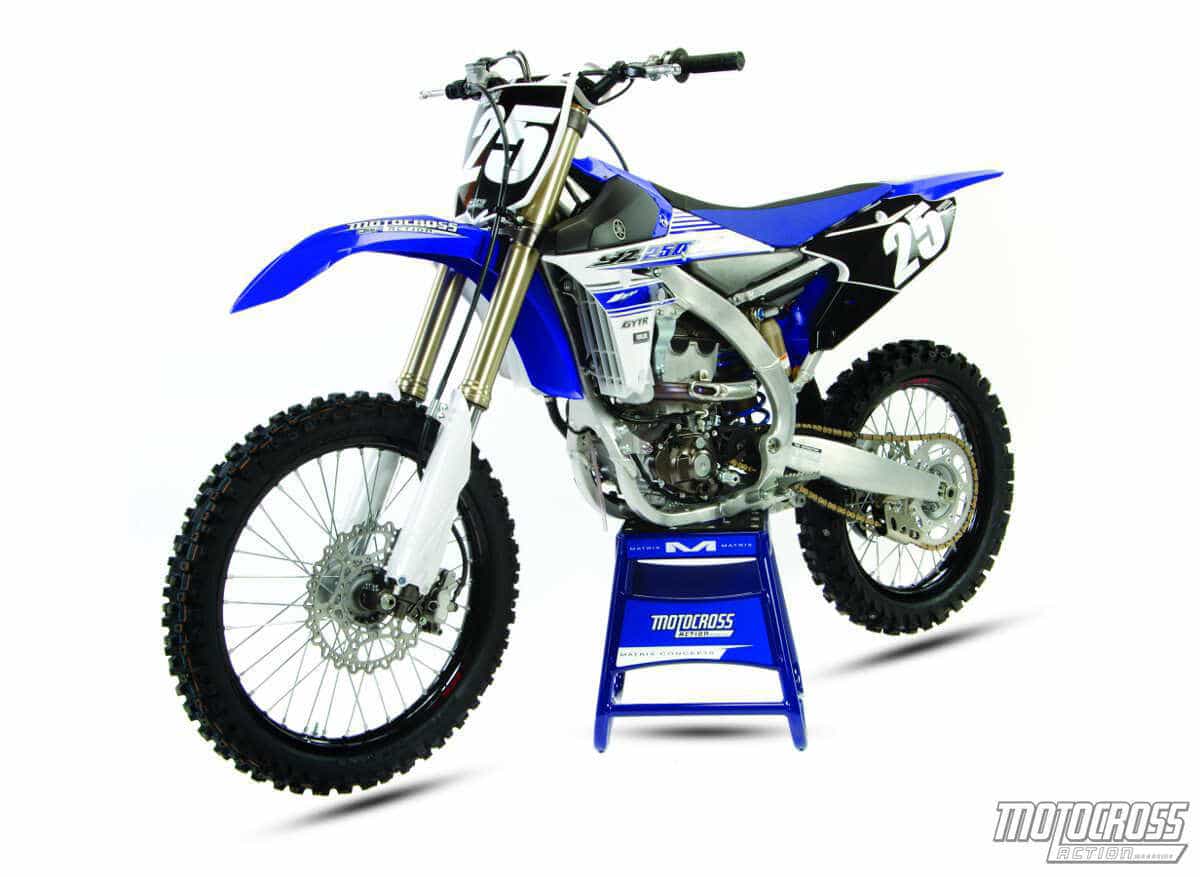 2016 Yamaha YZ250F: The focus of the 2016 YZ250F wasn’t on mega-horsepower, but instead on maximum reliability. Every mod was made with durability in mind.
2016 Yamaha YZ250F: The focus of the 2016 YZ250F wasn’t on mega-horsepower, but instead on maximum reliability. Every mod was made with durability in mind.
(4) Shifting. Yamaha made three changes to the shift system on the 2016 YZ250F. First, the neutral detent on the shift drum was reduced in width to make it less likely that the YZ250F will hit neutral in motion. Second, the engagement corners of the dogs on third, fourth and fifth gears were reshaped to insure more positive engagement. Finally, the shift stopper design was changed for the third time in three years. Originally, the shift stopper interacted with the shift detent wheel via a bearing-equipped roller; however, the bearing had the poor taste to disintegrate, so Yamaha replaced the bearing roller with a solid metal roller. Unfortunately, this solid metal roller was only supported by an arm on one side and would flex. Now, for 2016, the solid roller is supported by arms on both sides and is held into the shift detents by a 20-percent-stiffer spring.
(5) Suspension. Although Yamaha would be foolish to abandon its class-leading Kayaba SSS suspension, Yamaha did make small changes to the front and rear units. The forks have less low-speed damping and more high-speed damping, while the rear shock gets a softer spring rate (from 56 N/m to 54 N/m). Both of these changes are designed to make the suspension more absorbent, especially for smaller riders.
(6) Front brake. For 2016, Yamaha has joined the “Let’s Catch Up to KTM” movement by going from its previous old-school 250mm front rotor to a 270mm rotor (along with higher MU friction brake pads). That leaves Suzuki as the outlier in the brake world.
Q: WHAT EFFECT DO THESE CHANGE HAVE ON THE 2016 YAMAHA YZ250F?
A: If we are talking outright performance improvements, only the oversized front rotor is going to be noticeable. The rest of the 2016 modifications are all made in the name of durability. Although Yamahas have a reputation for incredible reliability, that reputation comes largely from the bulletproof YZ450F. Over the past few years, the YZ250F has suffered some high-profile failures, most recently with the water pump shaft and shift stopper roller. Thus, 2016’s efforts to beef up the running gear will produce a better product for the consumer than some random hop-up mod. The YZ250F is already a 250 shootout contender, and the engineers don’t need to add performance mods until they increase durability. Of course, we would have preferred all of the durability mods and one more horse on top, but given a choice, we think Yamaha made a wise choice.
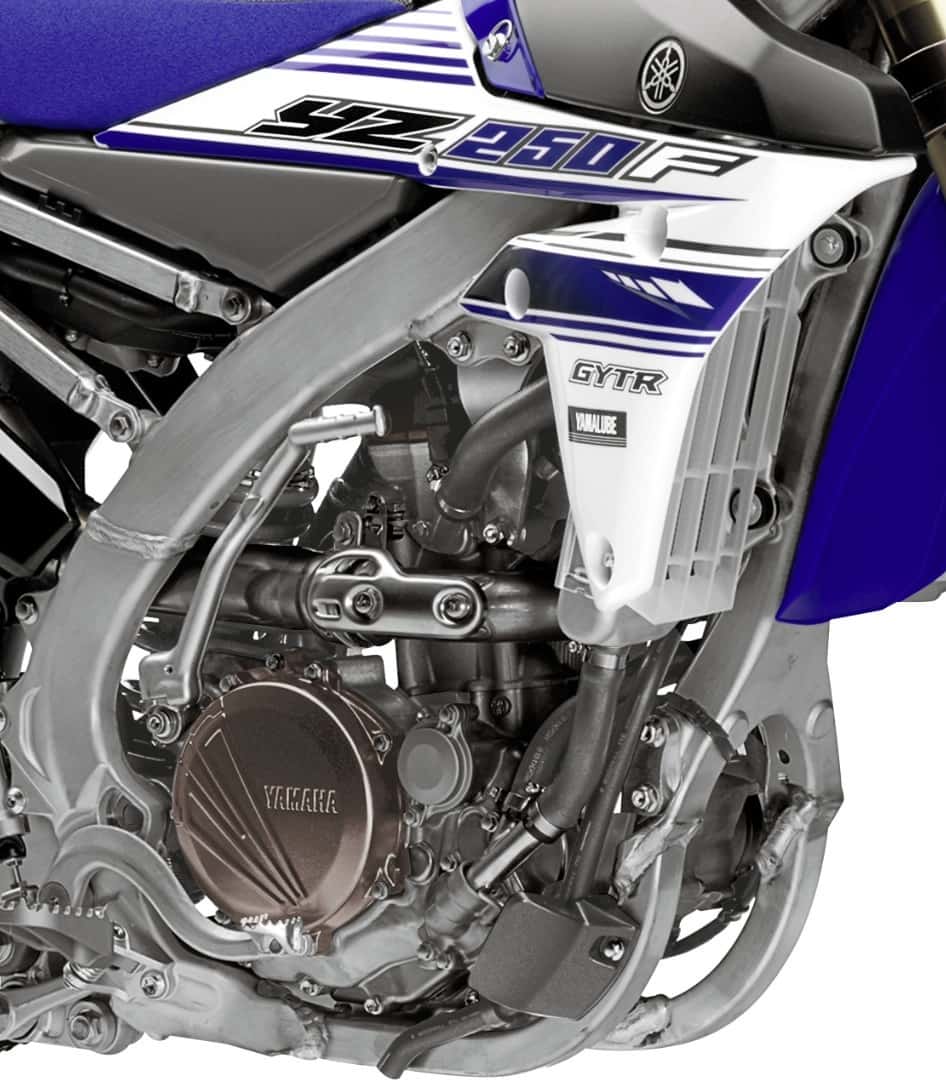 Underdog: Although it gives up 4 horsepower to the KTM 250SXF, the YZ250F has a few powerband tricks up its sleeve.
Underdog: Although it gives up 4 horsepower to the KTM 250SXF, the YZ250F has a few powerband tricks up its sleeve.
Q: IS THE 2016 YAMAHA YZ250F FASTER THAN THE 2015 MODEL?
A: No. Nothing that was done to the 2016 engine was going to return heaps of horsepower. Plus, the Yamaha YZ250F already had a fast engine. As it sits, the YZ250F delivers a style of power that riders of all skill levels can use to the fullest. It pulls harder through the middle, doesn’t require a quick-draw clutch hand to keep it on the pipe and has just enough rev to get the job done. Even when it runs out of over-rev on top, the engine signals the end of days by having a slower pulse to the rev limiter’s cut out in 2016 than in 2015. Instead of going rat-a-tat ratty, it has a slower da-da-da sound. You need to memorize that sound, because it is the Def-Con 4 signal to shift.
With the exception of the rev limiter’s engagement, the 2016 YZ250F feels just like the 2015 YZ250F. No shame in that. The 2016 YZ250F powerband is remarkable in its power placement. Yamaha put the power where every rider can get the most out of it. It really shines in the midrange, which is a good thing, because it can’t come close to touching the 2016 KTM 250SXF on top. The KTM 250SXF is best suited to Pro riders—after all, it makes its peak horsepower at 13,800 rpm. And, not many Novices are going to extract the last ounce of power from a bike that has to be ridden at full shriek.
Success on the YZ250F, especially against the KTM 250SXF, comes from hitting your shift points perfectly. If you try to match the orange flyer rev for rev, you will find yourself on the losing end of a horsepower war. But if you shift at 11,500 rpm, you will stay in the Yamaha’s wheelhouse—any higher and you will be playing in KTM’s ballpark.
Q: HOW DOES THE 2016 YZ250F RUN ON THE DYNO?
A: Since a quick perusal of the modifications that Yamaha made to the 2016 YZ250F don’t point to any improvements in the power department, we weren’t disappointed to discover that at no spot on the dyno curve was the 2016 YZ250F better than the 2015. Peak horsepower was 39.35 at 11,800 rpm with torque at 20.44 foot-pounds at 8400 rpm.
When it comes to horsepower, the YZ250F is just shy of 40 big ones. That is a solid number, except for the fact that the KTM 250SXF engine pumps out 43.79 horsepower at 13,200 rpm, with 20.20 foot-pounds of torque at 8800 rpm and its kissin’ cousin, the Husqvarna FC250 makes 44.38 horsepower. Even the 2016 KX250F beats it on the dyno with a 39.88. Which means that on dyno numbers alone, the YZ250F shouldn’t be able to run with the Katoom or the Husky. But it can. Not because it makes more horsepower (it doesn’t), but because it makes more torque from 5000 rpm to 9000 rpm. Torque is the thrust that allows the YZ-F to get the jump on the SXF leading into the midrange—and why a YZ250F racer never wants to play high-rpm chicken with a KTM or Husky racer.
Q: IS YAMAHA’S SSS SUSPENSION STILL THE BEST?
A: You bet. As air forks proliferate on the dealer’s showroom floors, the siren call of Yamaha’s coil-spring-equipped Kayaba SSS forks is even more melodious. MXA has always been a big proponent of Kayaba’s old-school suspension; it dates back to 2006. We love the way SSS suspension works. It is the only fork that can be used by a Beginner, Novice, Intermediate and Vet with nothing more than a clicker change. Forget everything you know, believe or have heard about PSF-2 or TAC air forks. They can’t hold a candle to Yamaha’s 10-year-old coil-spring forks.
MXA test riders aren’t blind to the potential of air forks, but we aren’t deluded enough to believe that the constantly changing protocol of air forks has a ghost of a chance of catching up to the fluid perfection of Kayaba’s ground-breaking SSS forks any time soon. As in most years, Yamaha hasn’t stood pat with its SSS components. Yamaha made damping changes to the 2016 fork and went down one spring rate on the shock spring.
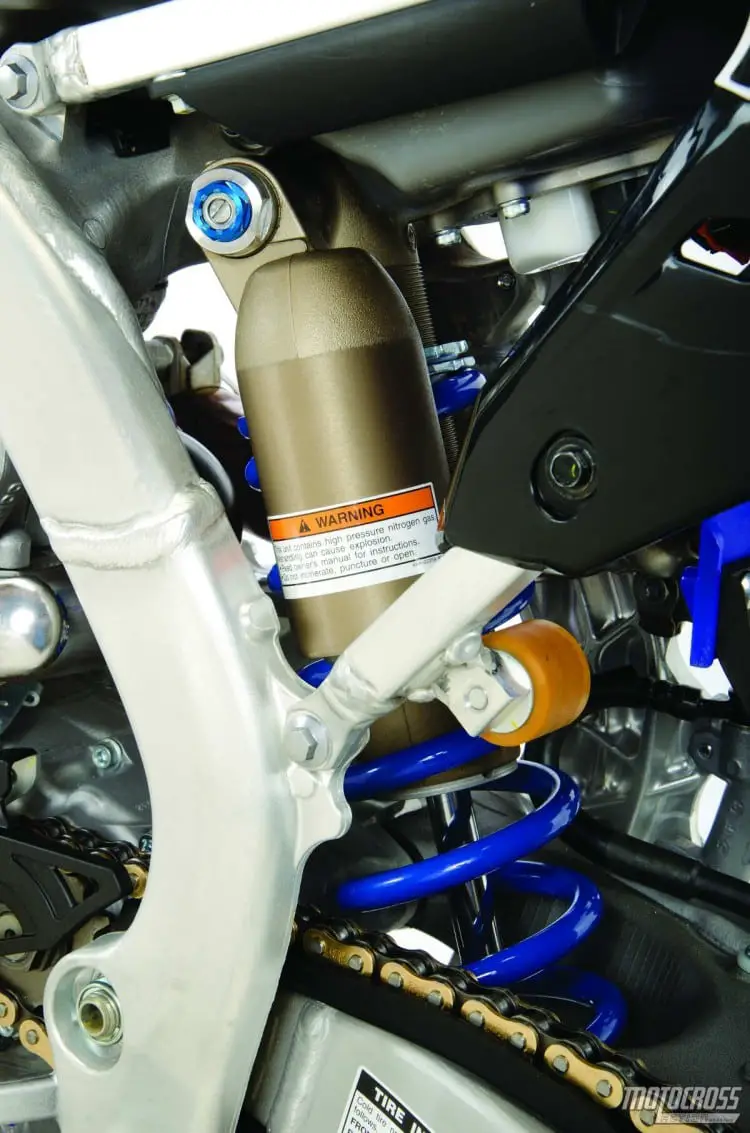
Softer: To better suit lighter riders the rear shock spring was changed from 56 N/m to 54 N/m.
Q: HOW DOES THE 2016 YAMAHA YZ250F HANDLE?
A: If we told you that the YZ250F uses the exact same frame geometry as the YZ450F, you might get spooked. But you can relax. The lighter-weight, lower horsepower and decreased rotating mass of the YZ250F drivetrain make it handle completely differently from the YZ450F frame. Unlike the YZ450F, the 250’s front end doesn’t feel loose on the entrance of turns or want to step out on the exit. But, the reality is that the 2016 YZ250F isn’t the best-handling bike in the class. Almost every other bike in the class can do something, even if it’s just one thing, better than the YZ250F. Even though the YZ250F doesn’t shine in any handling category, it also doesn’t suck wind in any category, either. The balance is slightly weighted to the rear, especially with the softer shock spring, but running a little less sag, sliding the fork legs down in the clamps and utilizing the high-speed compression adjuster to steady the pitch can make the YZ250F a very stable platform to work from.
Q: HOW MUCH DOES THE 2016 YZ250F WEIGH?
A: At 221 pounds, the YZ250F and KTM 250SXF are in a tie for the lightest bike in the class. When the YZ250F had a Keihin carb, it was 218 pounds. It should also be noted that KTM makes its fighting weight with an electric starter and battery (and next year it will have air forks which should make the 2017 KTM 250SXF weigh 218 pounds).
Q: WHAT DO WE HATE?
A: The hate list:
(1) Exhaust pipe. The YZ250F is blessed with an excellent performing stock exhaust system. But, if you plan to work on the engine, set aside ample time to get Yamaha’s jigsaw puzzle of a pipe off the bike. It has twice as many bolts as any other exhaust system.
(2) Air filter. We hate the Dzus fasteners that hold the airbox cover. They seem like a good idea until they rip your pants or fall out. We remove the D-rings (and use a screwdriver to remove the bolts) or cover them with duct tape. We also remove the backfire screen from the airbox and replace it with a Twin Air Powerflow kit, which comes with an aluminum cage and a flame-retardant air filter. You could cut the wire out yourself, but be sure to order a fire-resistant Twin Air filter. You will feel an improvement in throttle response and some of the annoying intake sound will be lessened.
(3) Boom box. The noise that comes out of the gas tank-mounted airbox is irritating. You’ll get used to it over time in the same way that people who live on the flight path to LAX get used to jets landing
(4) Gearing. Faster test riders experimented with a one-tooth-taller (49-tooth) sprocket; it allowed them to carry more speed from turn to turn.
(5) Radiator wings. We prefer Cycra radiator shrouds. They are thinner, lighter and less complex. Yamaha’s stock airbox design has been improved over the past few years, but it has a long way to go.
(6) Gas cap. Don’t put it on too tightly, because it sticks (and the little winglet on top doesn’t offer much leverage).
(7) Handlebars. Half of the MXA test riders had issues with the bar bend—and they had Yama-thumb to prove it.
 Welcome to the club: Yamaha bit the bullet and became the third Japanese manufacturer to spec a 270mm front rotor.
Welcome to the club: Yamaha bit the bullet and became the third Japanese manufacturer to spec a 270mm front rotor.
Q: WHAT DO WE LIKE?
A: The like list:
(1) Suspension. Forget air forks! Kayaba’s SSS units are works forks for the masses.
(2) Mapping. The GYTR Power Tuner is a must-have item. We were able to improve the YZ250F powerband by changing the ignition and fuel-mapping settings. The Power Tuner comes in handy after installing an aftermarket pipe, porting the head or running race fuel. See MXA’s recommended map settings for the stock pipe and pump gas above.
(3) Front brake. The only manufacturer who didn’t accept the invitation to the oversized front brake party is Suzuki. Yamaha went to 270mm for 2016.
(4) Tires. We’ve long had a love affair with Bridgestone’s 403/404 sneaker combo. The rubber works well in a variety of conditions and holds up well to abuse.
(5) Choices. Yamaha is the only manufacturer to offer a motocross model in two different colors—blue or yellow. We prefer the blue combo, but to each his own. The yellow costs $100 more.
(6) Reliability. Although it doesn’t have the buzz of electronic gizmos and mega-power mods, Yamaha’s reliability updates are sound marketing.
(7) Clutch. In a left-handed compliment, the YZ250F has the best clutch of any Japanese-designed 250 four-stroke.
(8) Power. Yamaha’s power profile is one of quality instead of quantity. It makes do with less horsepower, because it puts the power where most people want it to be.
Q: WHAT DO WE REALLY THINK?
A: In a reversal of roles, Yamaha has positioned the YZ250F as David versus Goliath (with Goliath being the KTM 250SXF). That’s so strange, because KTM has always been the underdog boutique manufacturer that fought against the leviathan Japanese brands. My, how the times have changed. David has become Goliath and vice versa. The 2016 Yamaha YZ250F is throwing 40-horsepower stones against the 44-horsepower Goliath. It can only win the battle if the stones are all lined up and ready to throw and each one hits the target.
MXA’S YAMAHA YZ250F SETUP SPECS
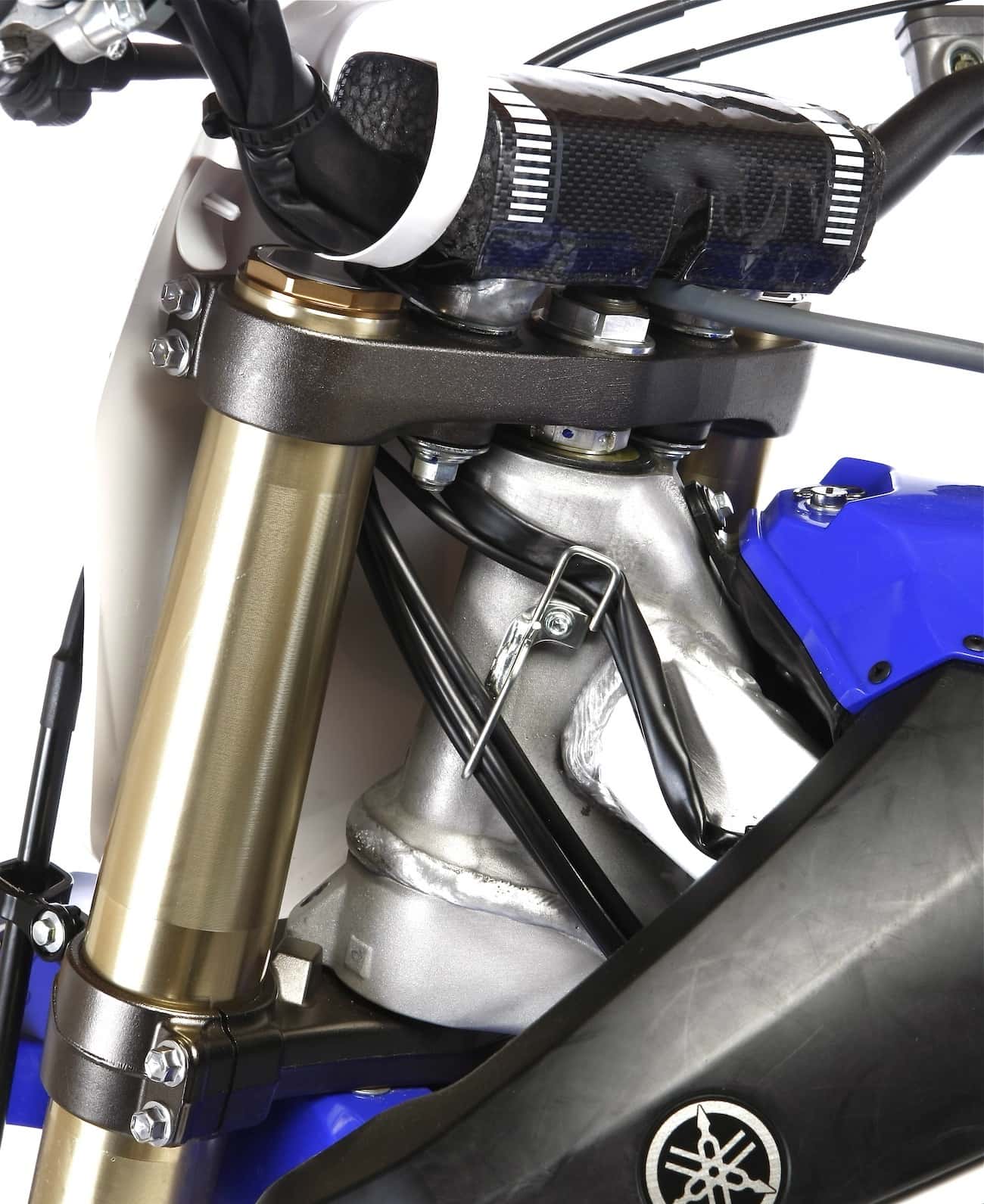
This is how we set up our 2016 Yamaha YZ250F for the track. We offer these settings to help steer you in the right direction.
KAYABA SSS FORK SETTINGS
If you are under 150 pounds, consider dropping the fork springs to the optional 4.5 N/m rate. You can also lower the oil height in 5cc increments until the desired performance is met. Most MXA test riders felt that the fork springs were sufficient for a wide range of rider weights and speeds. For hard-core racing, we recommend this fork setup for the 2016 Yamaha YZ250F (stock specs are in parentheses):
Spring rate: 4.7 N/m
Compression: 14 clicks out (10 clicks out)
Rebound: 10 clicks out (12 clicks out)
Fork-leg height: 5mm up
Notes: Don’t be afraid to make very large swings in compression and rebound clicker settings. We tested everything from 10 clicks out to 20 clicks out. These big alterations help you zero in on the perfect numbers for your style. As a rule of thumb, we ran less compression damping than stock and more rebound.
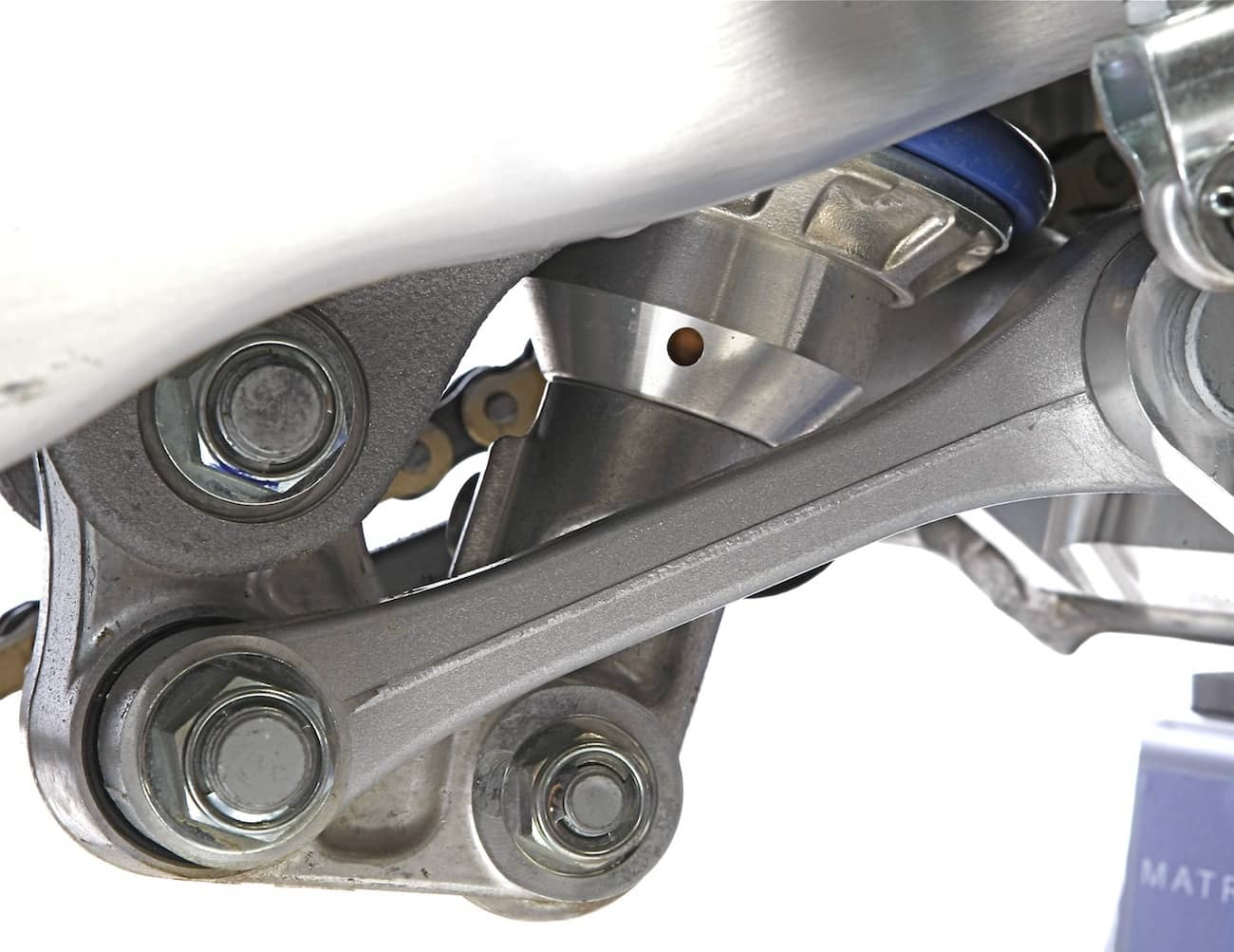 KAYABA SSS SHOCK SETTINGS
KAYABA SSS SHOCK SETTINGS
Last year we were surprised to discover that shock performance improved every time we softened up the low-speed compression. So, for this year, Yamaha spec’ed a lighter shock spring rate, which softened up the low-speed compression with or without clicker changes. The lighter spring is better suited to the target audience of the YZ250F (under 160 pounds), but amazingly it works okay for riders as heavy as 180 pounds. We have always complained about the YZ250F’s rear suspension kicking in the rough. The new 54 N/m spring doesn’t eliminate this complaint, but it, and a little less high-speed compression, helps. For hard-core racing, we recommend this shock setup for the 2016 Yamaha YZ250F (stock specs are in parentheses):
Spring rate: 54.0 N/m
Race sag: 102mm
Hi-compression: 1-1/2 turns out (1-1/4 turns out)
Lo-compression: 15 clicks out (12 clicks out)
Rebound: 10 clicks out (13 clicks out)
Notes: The shock has a tendency to hop under heavy braking and down rough straights. We sped up the high-speed compression and softened up the low-speed compression.
MXA FIRST RIDE 2016 YAMAHA YZ250F




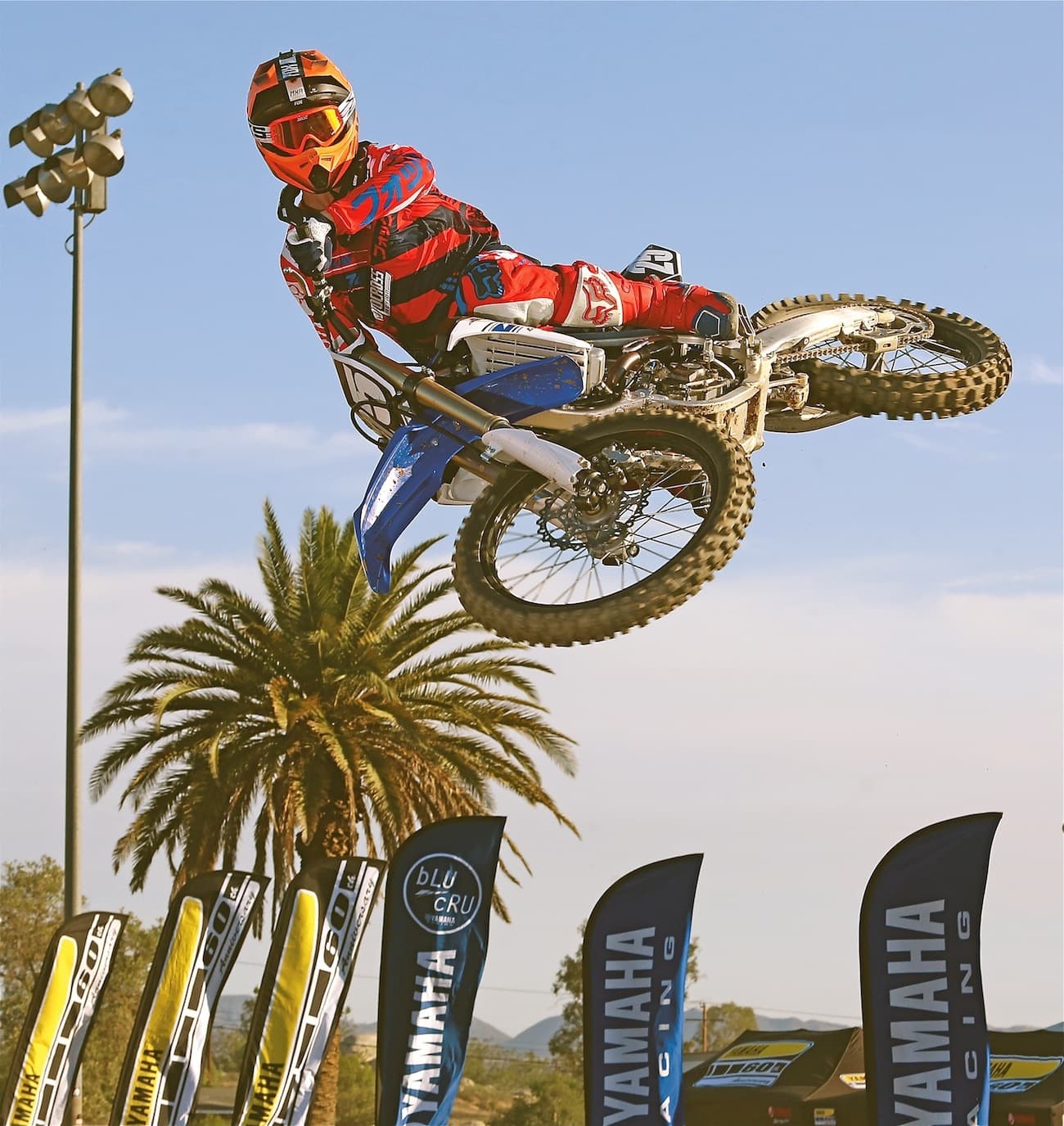
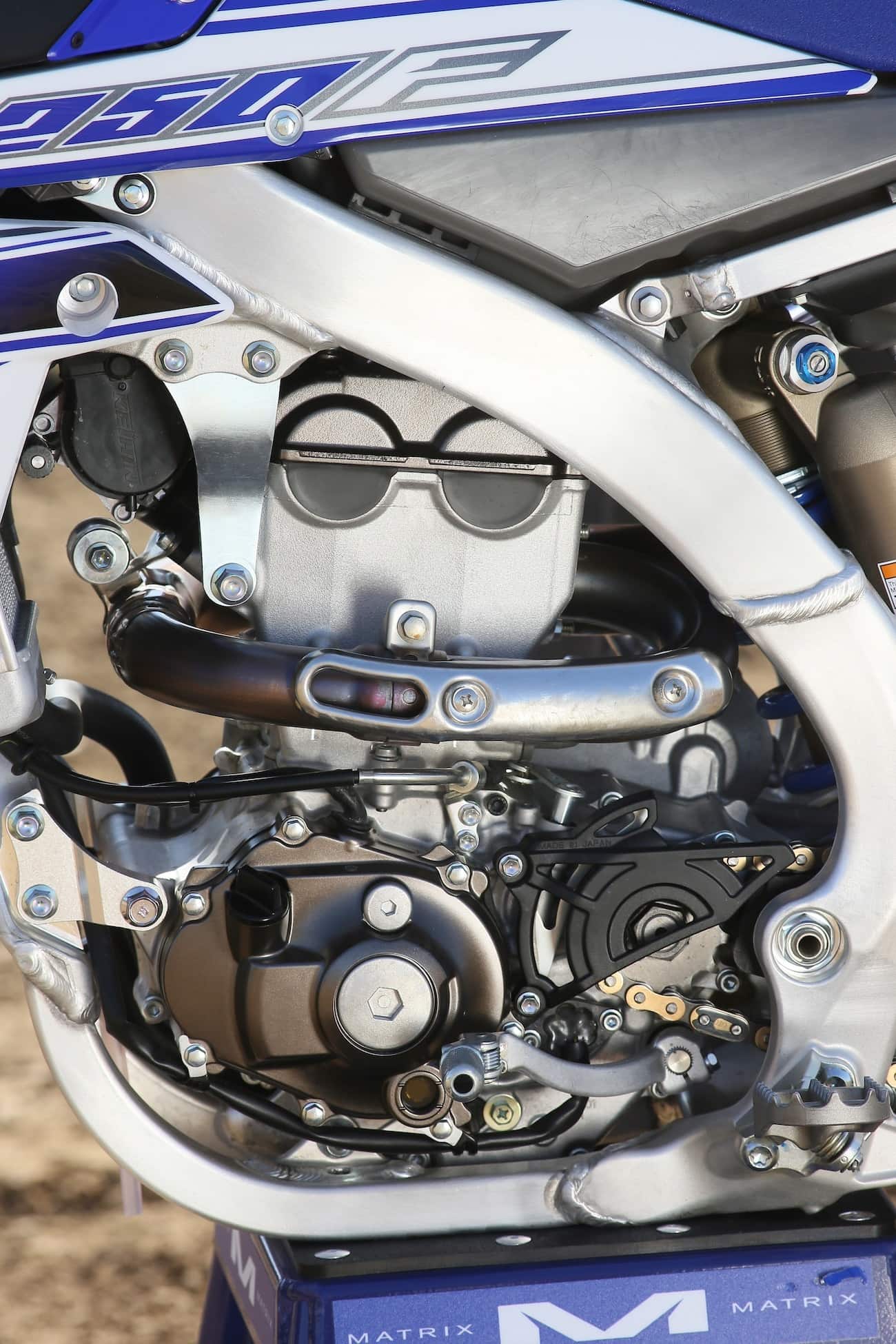
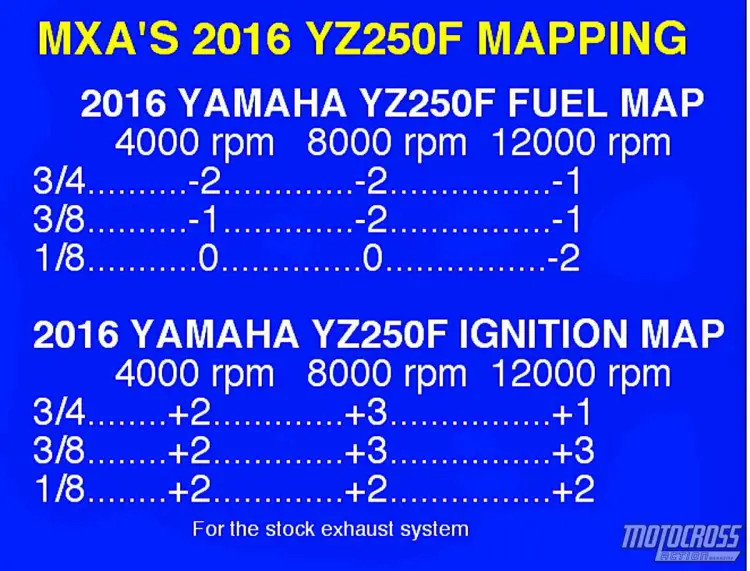


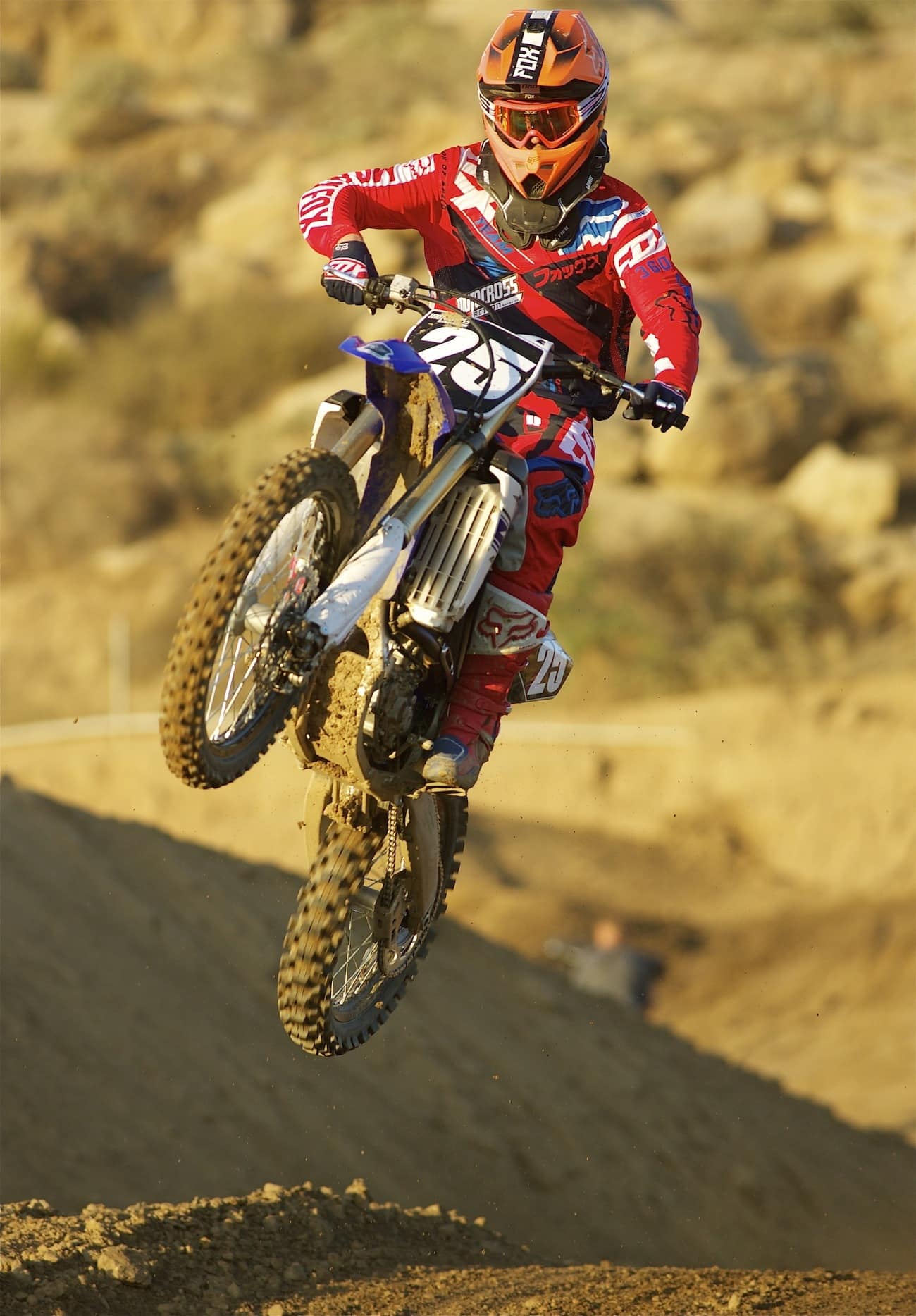




Comments are closed.